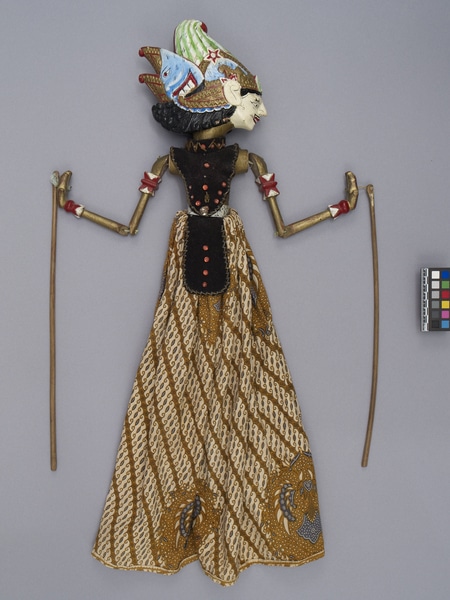Rod Puppet Item Number: 2872/14 a-c from the MOA: University of British Columbia


Description
Wayang golek rod puppet of the character Batara Wisnu. The head carries an elaborate headdress that incorporates images of the eagle deity Garuda on each side, covering a fringe of black hair. The face is painted white with carved features finely outlined in black. The mouth is red and smiling, surrounded by a curling moustache and small beard. The torso is covered by a black, sleeveless, beaded hanging below which is a sarong belted at the waist. The sarong hides a wooden stick that extends through the torso to control the movement of the head. The golden arms are moveable at shoulder and elbow by wooden sticks attached to each hand, and are decorated with red and gold bracelets.
History Of Use
Javanese puppetry as an art form probably developed by the 11th century. The three-dimensional wooden wayang golek puppets of western Java, which are to be distinguished from the earlier and more sacred wayang kulit shadow plays puppets or other forms, appeared during the 16th century. Originally the plays depicted Javanese mythology, but after the Indian conquest of Java the Hindu epics, Ramayana and Mahabharata, were incorporated into the cycles, which comprise about 200 plays. An individual or group hires a dalang (puppet-master) to celebrate important occasions. The performances often last all night and are generally presented in three acts, with vocal and instrumental accompaniment. The individual plays vary widely in detail but usually involve conflict between good and evil. They serve a moral and religious purpose, and more recently, one of political commentary. Each puppet's character is represented by its appearance and placement on stage; protagonists with strong elements of good are placed to the right, antagonists of violent or evil nature to the left. This character is named Wisnu, god and protector.
Iconographic Meaning
Batara Wisnu, god of justice and wisdom.
Item History
- Made in Java, Indonesia
- Collected between 1990 and 1999
- Owned by Betty Cairney
- Owned by Jack Cairney before March 15, 2011
- Received from Jack Cairney (Donor) on March 15, 2011
What
- Name
- Rod Puppet
- Identification Number
- 2872/14 a-c
- Type of Item
- puppet
- Material
- wood, cotton fibre, plastic and paint
- Overall
- height 81.0 cm, width 16.0 cm, depth 6.5 cm
Who
- Culture
- Sundanese
- Previous Owner
- Betty Cairney and Jack Cairney
- Received from
- Jack Cairney (Donor)
Where
- Holding Institution
- MOA: University of British Columbia
- Made in
- Java, Indonesia
When
- Collection Date
- between 1990 and 1999
- Ownership Date
- before March 15, 2011
- Acquisition Date
- on March 15, 2011
Other
- Condition
- good
- Accession Number
- 2872/0014 a-c